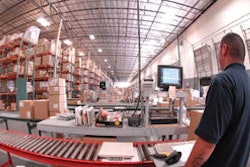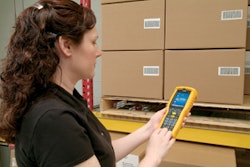
COOP AT A GLANCE
Headquarters: Basel, Switzerland
Number of employees: 50,000
Number of locations served: More than 1,800 stores throughout Switzerland
Distribution centers: Four national (including two deep-freeze) and 17 regional
While the machinery, speed and complexity of a highly-automated facility is impressive, the technology running these systems is just as noteworthy. Behind the scenes, warehouse management systems guide, control and monitor all of the material handling activities and, at the same time, optimize business processes throughout the supply chain.
For Coop, a Swiss cooperative that operates the second largest supermarket chain in Switzerland, its warehouse management system (WMS), supplied by SSI Schaefer Group, plays a critical role in its supply chain—and ultimately in the company’s overall success. Annual sales topped more than $18 billion last year, due in part to the outstanding customer service and order fulfillment levels that it has been able to achieve using this technology.
Coop services more than 1,800 stores throughout Switzerland from 21 distribution centers, all of which run by the SSI Schaefer WMS. The company operates a wide range of store formats, including food, non-food, drug, building and hobby, furniture, restaurant and service stations, as well as an online grocery home-delivery program that reaches 60 percent of Swiss households.
It also runs a number of manufacturing plants, including meat, chemicals and cosmetics, chocolates, pasta, rice and bread, producing its own brands as well as flagship labels. In addition, Coop publishes a weekly magazine in three languages—French, German and Italian—reflecting the various languages spoken in Switzerland.
Coop employs more than 50,000 people, making it the third largest employer in Switzerland.
“Our goal is to be number one in Switzerland,” says Philippe Huwyler, Coop’s IT operations manager. “We want to be closer to the customer than any other retailer in the country. We offer our customers a variety of shopping venues, the freshest products and the best brands—all at reasonable prices. We cater to a diversity of tastes, so we carry more than 35,000 SKUs ranging from low-price good-quality items to fine food and premium-grade specialties. Forty percent of our business is our own private brands.
“Sustainability is very important for us as well,” adds Huwyler, “and we consider ourselves the leader in environmentally friendly and fair trade products.”
In recent years, Coop has worked on reducing its carbon footprint in both its stores as well as its distribution centers and manufacturing plants. Energy saving measures include reducing water, electricity and diesel use and refurbishing stores and facilities to be more energy efficient. One-third of all its inbound shipments are received via rail and its drivers are trained in “Eco-Driving,” a program which can reduce fuel costs by 10 to 15 percent.
In 2001, Coop merged 14 different cooperatives into one company, which is based in Basel, a city about 50 miles west of Zurich. To gain further efficiencies, it reorganized into five sales regions and consolidated its distribution network into four national distribution centers and 17 regional DCs.
Coop was using SAP 4.7 as its standard order processing, ERP management and financial accounting software. The company, however, did not have a WMS that met its requirements, which included controlling a variety of automated storage and retrieval systems and various picking processes—such as pick-to-light and voice recognition systems—throughout its various distribution centers.
“We were facing many logistical challenges, such as on-time deliveries and keeping our shelves stocked, but we had other issues as well,” says Huwyler. “We wanted a WMS that could integrate with our SAP system that could help us with category management, purchasing, sales and tracking and tracing product throughout our supply chain.”
The company also wanted to be able to link its manufacturing facilities into the WMS, so that it could monitor the production of products, such as bread, which is delivered to its stores each day.
The company decided to implement the WMS solution from SSI Schaefer’s subsidiary, Salomon Automation. “We chose Salomon because of their experience in the market,” says Huwyler, who oversaw the installation of the WMS system. “They’re known for having good retail solutions. It took us five years to implement the system, which we integrated into our logistics processes.”
All 21 of the distribution centers now run the SSI WMS, which is linked to Coop’s central SAP system via IDOC-interface. IDOCs enable the connection of different application systems using a message-based interface. Orders are entered into the SAP system and then forwarded to the SSI WMS. From there, the WMS solution controls the product and information movement throughout the warehouse and to the store.
“The entire flow of goods is computer-controlled through the SSI WMS and SAP,” says Martin Nyfeler, software manager, Salomon Automation. “The relevant dynamic data such as inbound, stock and shipping (orders) is updated just in time between SAP and the WMS”.
The Schaefer WMS systems were initially installed in the four national distribution centers including deep-freeze high-bay warehouses in Hinwil and Givisiez. These facilities are fully automated, equipped with two pallet cranes as well as pick-to-light systems. There are 3,250 pallet storage locations and 270 pallet pick locations. There are also 9,350 totes with 500 pick locations. The pick-to-light systems make it easier for employees to work in sub-zero temperatures. Frozen products are distributed throughout Switzerland from these two locations.
All of Coops’ distribution centers use a variety of picking applications—like paper, radio frequency on hand-held devices and lift trucks, voice and pick-to-light.
Whatever the application is, the SSI WMS directs the pickers, assigns shipping codes, prints shipping labels for transport, and prints store orders and receipts for confirming goods sent. Some DCs ship goods by pallet; others use roll carts that are sequenced by store aisle.
Since installing the SSI Schaefer WMS system, Coop has achieved a 10 to 15 percent increase in productivity and significantly reduced logistics costs. Customer service levels have improved and out-of-stocks have been reduced.
“We really work smarter thanks to the SSI WMS solution,” says Huwyler. “Our integrated system has allowed us to optimize costs along the supply chain—and is enabling us to be better than our competitors. Freshness sets us apart—and we could never achieve our goals with this technology.”



















